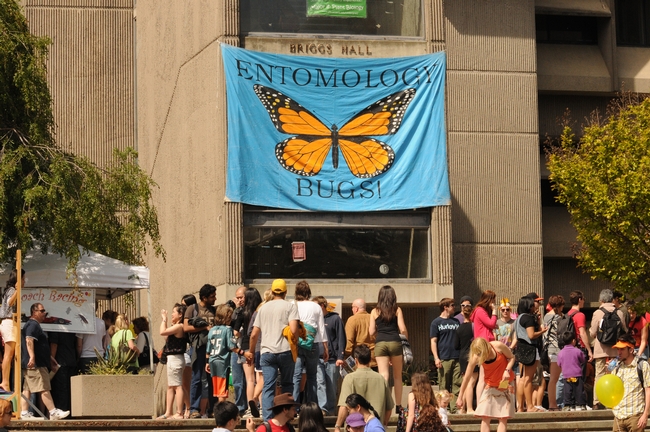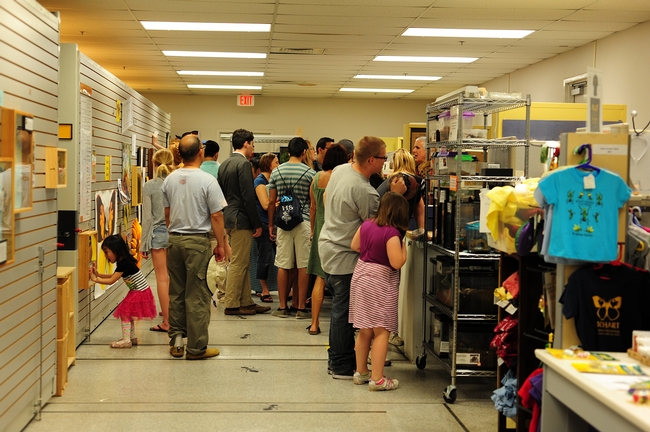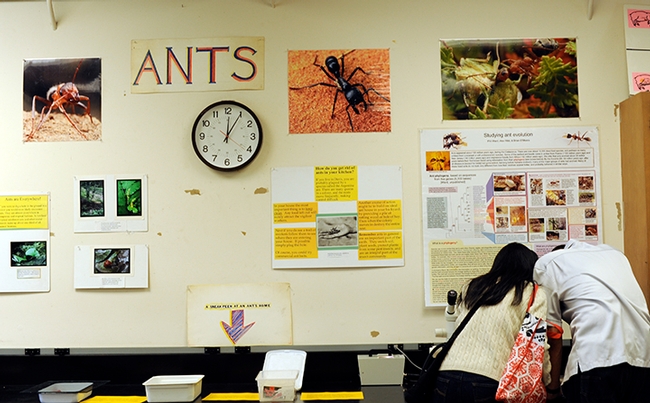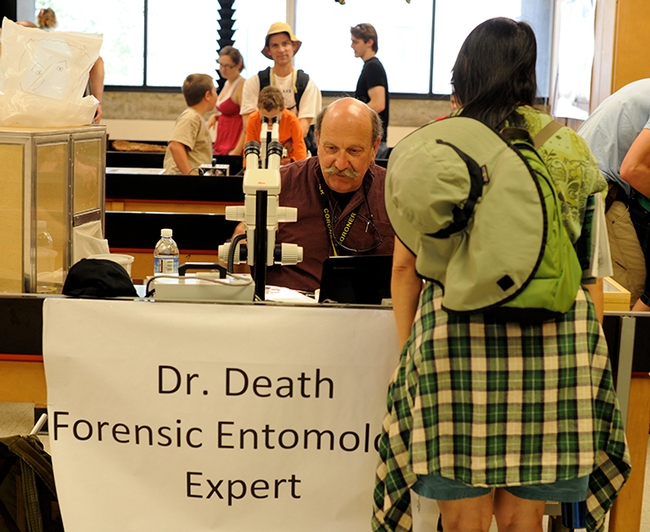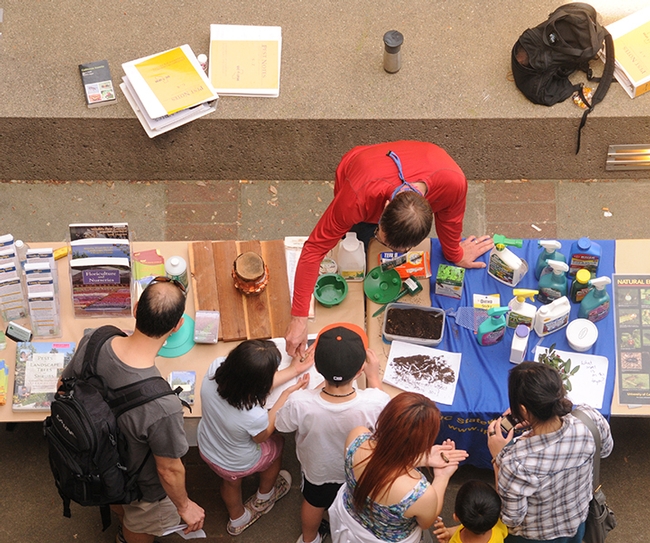- Author: Kathy Keatley Garvey
Bob stole the show.
Picture this: UC Davis forensic entomologist Robert “Bob” Kimsey is portraying “Dr. Death” inside Briggs Hall during the 109th annual UC Davis Picnic Day, but just outside the building, another Bob is grabbing the spotlight.
That would be Bob, a two-inch long American cockroach, Periplaneta americana, competing in the Roach Races.
"Roach Bob" is part of the colony that "Dr. Bob" inherited from the late entomology emeritus professor Charles Judson (1926-2015).
Every year someone names a roach “Bob” to honor the colony keeper.
The reddish-brown roaches race inside a tubelike track. An air pump, emitting "a gentle breeze," encourages them to leave the starting gate and head for the finish line--all six legs flying.
This year Bob, Speedster and Charlie proved to be crowd favorites.
“We rotate the roaches so they don't get too stressed from the heat, but Speedster definitely lived up to its name,” said Roach Race coordinator Taylor Kelly, a doctoral candidate in the lab of medical entomologist/geneticist Geoffrey Attardo, associate professor, UC Davis Department of Entomology and Nematology.
“Bob was a definite winner,” said race announcer-roach handler Iris Quayle, a first-year doctoral student in the lab of Jason Bond, the Evert and Marion Schlinger Endowed Chair in the UC Davis Department of Entomology and Nematology and associate dean, UC Davis College of Agricultural and Environmental Sciences. “I don't think the crowd knew they were naming a cockroach after Bob Kimsey but it worked out well. And the aptly named Speedster gave everyone a run for their money!”
Kimsey's wife, Lynn Kimsey, a UC Davis distinguished professor and director of the Bohart Museum of Entomology, also is honored annually with a roach named “Lynn.” Last year her namesake won a few races; this year, no.
“We had audience members be our Roach Coaches--they encouraged the roaches to run with a gentle breeze of air,” Taylor said. “Later on in the day, we had a very speedy roach named Charlie that clinched 4 rounds back-to-back. Charlie was named by a youngster participating as his Roach Coach. He named the cockroach after his little brother.”
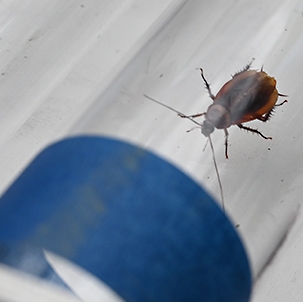
“At the beginning of the day we had some near-escapees and definitely elicited some screams from the crowd when one managed to get free,” Iris said, “but Taylor and I were too fast and were able to get them all back into the colony in the end. We also had some stubborn racers who didn't want to leave their racing tube after the competition.”
Some spectators asked Iris what the experience was like. “I did get a few questions about if I was okay holding them, and if I was scared I would get sick, but once I explained that this was a maintained colony by the college and that cockroaches are only as dirty as their environment, people came around and were even willing to give the racers a little head pat for good luck.”
In between races, the announcers asked if anyone wanted to pet a cockroach. They did, and took cell phone images and videos, too. “It was fun to let folks give the roaches a little head pat, a lot of folks said they seemed more cute after getting up close and personal,” Kelly said. “I hope folks loved roaches a little more after the races!”
Did anyone ask to take one home? “No, but we had many people complain that they already had too many lurking at home,” Taylor quipped.
Taylor was a member of the 2022 UC Davis Entomology Games team that won the national championship at the Entomological Society of America meeting. She also won the 2022 Student Leadership Award from the Pacific Branch, Entomological Society of America (PBESA) for her leadership in STEM and entomological activities.
Iris recently won first place in the doctoral student research competition at the 2023 PBESA meeting, held in Seattle. Her presentation, “Colorless but Never Dull: Unraveling Population Genetics and Color Evolution in ‘White' Darkling Beetles (Onymacris),” was her first-ever scientific presentation. Iris served a year as a National Science Foundation Research Experience for Post-Baccalaureate Students (NSF-REPS) in the Bond lab before being accepted into the doctoral program in 2022.
Kimsey, an associate adjunct professor and lecturer since 1990, has served as the master advisor for the animal biology (ABI) major since 2010 and an ABI lecturer since 2001. He also serves as the UC Davis Entomology Club advisor. He annually co-chairs the UC Davis Department of Entomology and Nematology's Picnic Day activities with a member of the Entomology Graduate Student Association (EGSA). This year he co-chaired the event with doctoral student Grace Horne of the lab of urban landscape entomologist Emily Meineke.
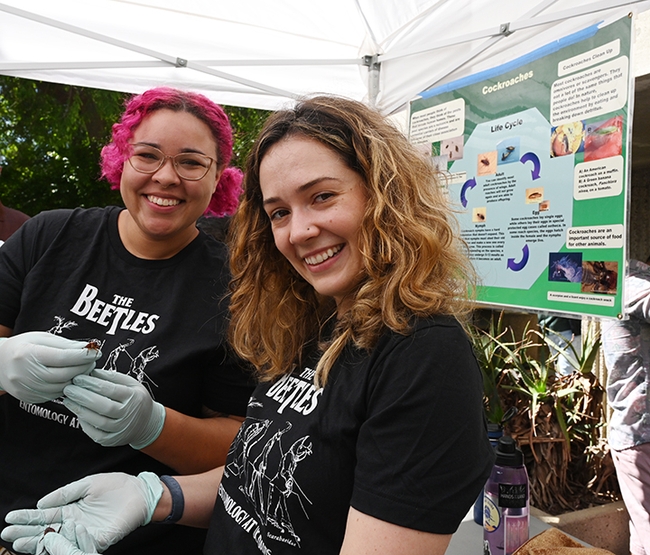
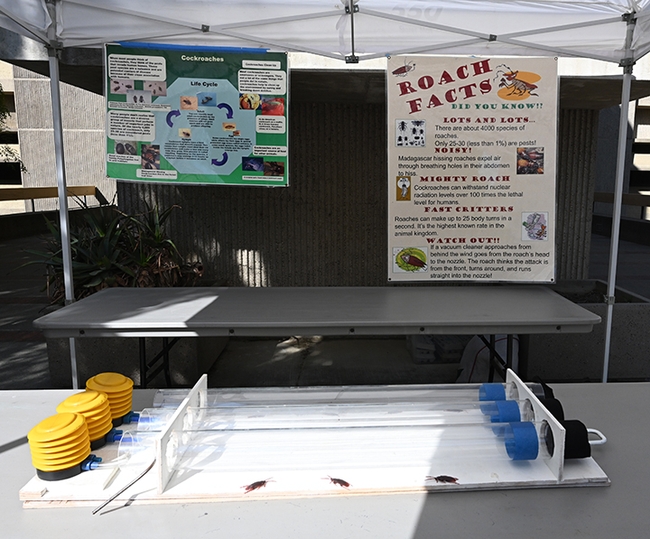
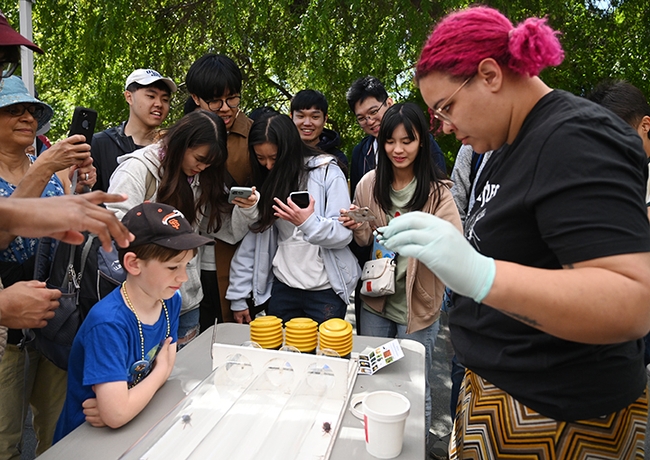
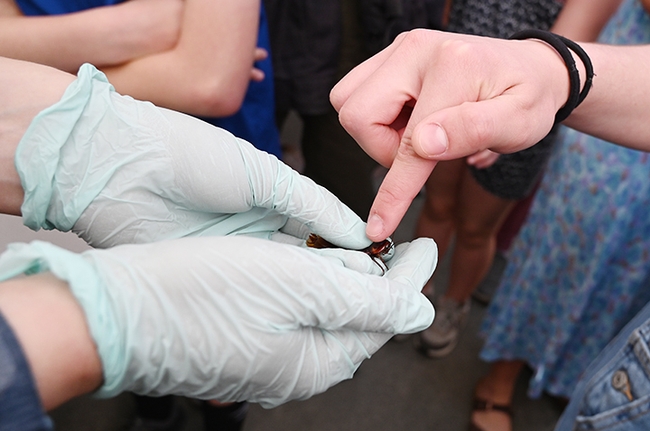
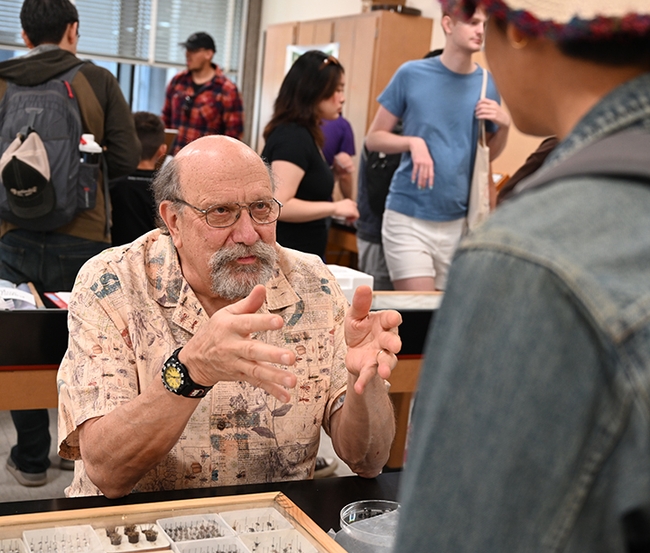
- Author: Kathy Keatley Garvey
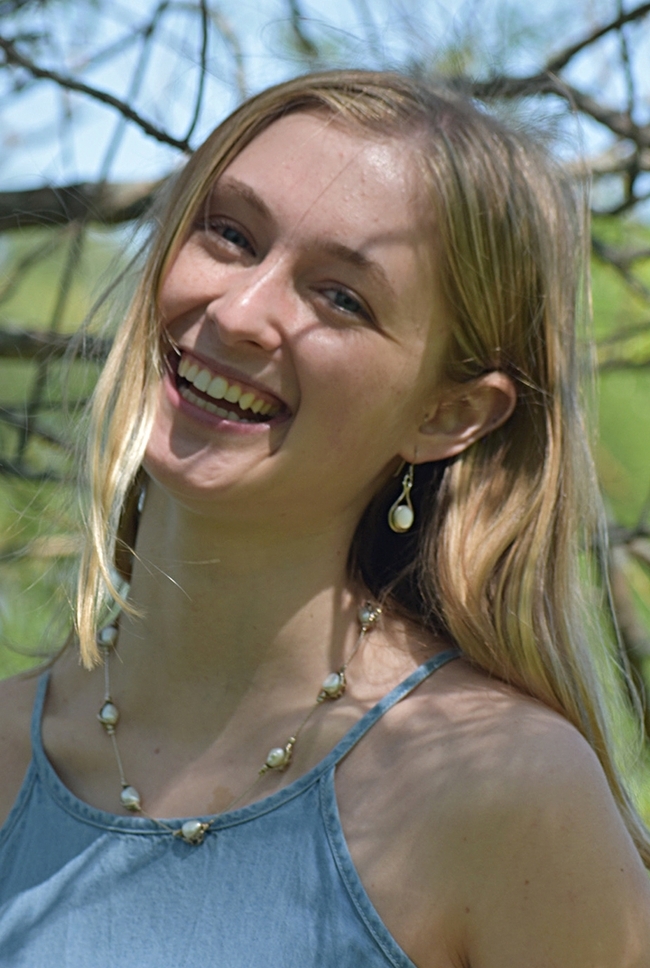
"We're ready," say forensic entomologist and faculty member Robert "Bob" Kimsey and doctoral student Grace Horne of the lab of urban landscape entomologist Emily Meineke. They are co-chairing the UC Davis Department of Entomology and Nematology's Picnic Day activities.
The 119th annual event, set Saturday, April 15, will include "bug" exhibits at two sites:
- Briggs Hall, home of the UC Davis Department of Entomology and Nematology, Kleiber Hall Drive, from 9 a.m. to 5 p.m., and
- Bohart Museum of Entomology, located in Room 1124 of the Academic Surge Building, 455 Crocker Lane, from 10 a.m. to 2 p.m.
Theme of the Bohart Museum will be "Bugs, Boom, Bang!" The insect museum, directed by UC Davis distinguished professor Lynn Kimsey, houses a global collection of eight million insect specimens, a live "petting zoo" (including Madagascar hissing cockroaches, stick insects and tarantulas).
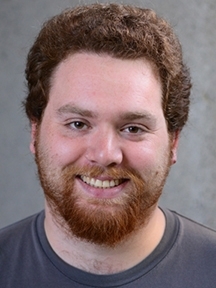
Bob Kimsey, who will staff the "Dr. Death" booth in 122 Briggs Hall, says he will be "pin-mounting and identifying flies from various different cases and research efforts and displaying some interesting studies on the sequence of development of individual maggots, and the development and sequence of communities of insects maggots in particular on decedents. By these means, approximations about how long a person has been dead can be made."
He also "will be talking about interesting cases that have recently been adjudicated and thus in the public domain."
The line-up of entomological events at Briggs Hall includes:
Bug Doctor
Briggs Hall Entryway
9 a.m. to 5 p.m.
Doctoral candidate Zach Griebenow and third-year doctoral student Ziv Lieberman, both of the Phil Ward ant lab, are read to answer your questions about insects. Bring an insect from your garden or a photo to identify.
Cockroach Races
Near Briggs Hall entrance
9 a.m. to 5 p.m.
Watch the American cockroaches, Periplaneta americana, race and cheer on your favorite.
Maggot Art
Briggs Hall Courtyard
9 a.m. to 5 p.m.
Create maggot art by dipping a live maggot into water-based, non-toxic paint. Voila! Art suitable or framing (or at least a spot on the refrigerator door
Dr. Death
Room 122 of Briggs Hall
9 a.m. to 5 p.m.
Forensic entomologist Robert Kimsey will display and discuss his work.
Entomology at UC Davis
Room 122 of Briggs Hall
9 a.m. to 5 p.m.
Displays of insects, including bees, ants and more
Graduate students, faculty and emeriti will staff the tables
Scavenger Hunt
Room 122 of Briggs Hall
9 a.m. to 5 p.m.
There will be several drawers of insects that people can look through to see if they can spot the insects on the check list
Fly-Tying
Briggs Hall courtyard
9 a.m. to 5 p.m.
Fly Fishers of Davis will show you how to tie a fly.
Insect-Themed T-Shirt Sales
Briggs hall entryway
9 a.m. to 3 p.m.
Members of the Entomology Graduate Student Association (EGSA) will be selling popular insect-themed t-shirts, including "The Beetles"
Mosquito Control
Briggs Hall entrance
9 a.m. to 5 p.m.
Sacramento-Yolo Mosquito and Vector Control District will be providing information on mosquitoes and how to protect yourself
Other Creepy Crawlies
122 Briggs Hall
9 a.m. to 5 p.m.
UC Davis doctoral candidate Emma Jochim of the Jason Bond lab and others will display live arachnids, myriapods, tarantulas, scorpions, millipedes and more
UC Statewide Integrated Pest Management (UC IPM)
Briggs Hall Courtyard
9 a.m. to 5 p.m.
Learn about pests and how to control them from UC IPM scientists. The staff will be giving away lady beetles, aka ladybugs.
The UC Davis Honey and Pollination Center, headed by director Amina Harris and affiliated with the UC Davis Department of Entomology and Nematology, will host a honey tasting from 10 a.m. to 2 p.m. in the courtyard of Robert Mondavi Institute for Wine and Food Science, 392 Old Davis Road. "Come taste and learn about UC Davis honey and honey varietals from North America," she said. "Honey available for purchase."
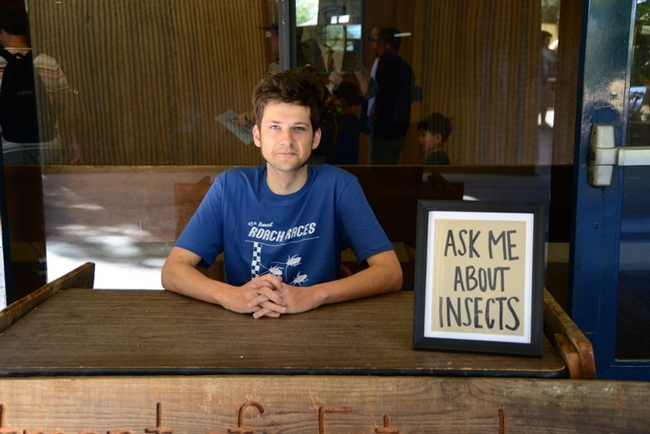
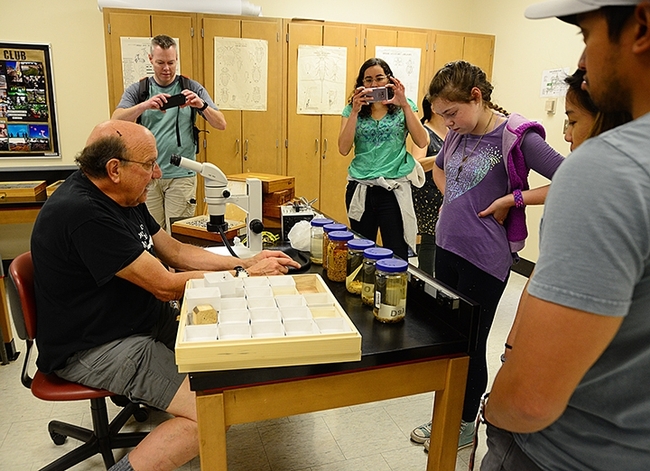
- Author: Kathy Keatley Garvey
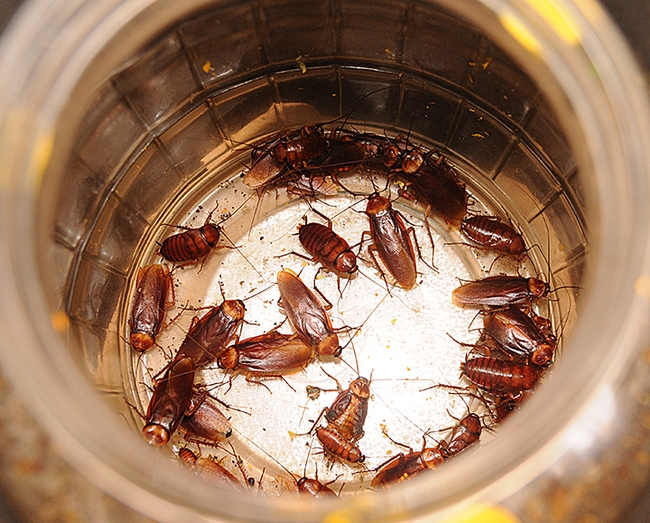
Forensic entomologist Robert "Bob" Kimsey and doctoral student Grace Horne of the lab of urban landscape entomologist Emily Meineke are busily coordinating the Department of Entomology and Nematology's activities and displays for the 109th annual UC Davis Picnic Day, set Saturday, April 15.
The "bug" exhibits will be at two sites:
- Briggs Hall, home of the UC Davis Department of Entomology and Nematology, Kleiber Hall Drive, from 9 a.m. to 5 p.m., and
- Bohart Museum of Entomology, located in Room 1124 of the Academic Surge Building, 455 Crocker Lane, from 10 a.m. to 2 p.m.
Theme of the Bohart Museum will be "Bugs, Boom, Bang!" The insect museum, directed by UC Davis distinguished professor Lynn Kimsey, houses a global collection of eight million insect specimens, a live "petting zoo" (including Madagascar hissing cockroaches, stick insects and tarantulas).
Cockroach races are among the popular activities at Briggs Hall. The roaches will run from 11 a.m. to 3 p.m. on a specially made race track in front of the building. These are American cockroaches, Periplaneta americana, from a colony kept by the late UC Davis entomology emeritus professor, Charles Judson (1926-2015). Bob Kimsey, who doubles as the advisor of the UC Davis Entomology Club, maintains the roach colony. The athletes, he said, "are ready to race."
The roach races involve a roach track, an air pump (to get the roaches moving), volunteers, and spectators. Sometimes a roach jumps from the track and lands on scurrying feet.
The line-up of entomological events at Briggs Hall also includes:
Bug Doctor
Briggs Hall Entryway
9 a.m. to 5 p.m.
Meet an entomologist and talk about insects! Bring an insect from your garden to identify.
Maggot Art
Briggs Hall Courtyard
9 a.m. to 5 p.m.
Create maggot art by dipping a live maggot into water-based, non-toxic paint. Voila! Art suitable or framing (or at least a spot on the refrigerator door
Dr. Death
Room 122 of Briggs Hall
9 a.m. to 5 p.m.
Forensic entomologist Robert Kimsey will display and discuss his work.
Entomology at UC Davis
Room 122 of Briggs Hall
9 a.m. to 5 p.m.
Displays of insects, including bees, ants and more
Graduate students, faculty and emeriti will staff the tables
Scavenger Hunt
Room 122 of Briggs Hall
9 a.m. to 5 p.m.
There will be several drawers of insects that people can look through to see if they can spot the insects on the check list
Fly-Tying
Briggs Hall courtyard
9 a.m. to 5 p.m.
Fly Fishers of Davis will show you how to tie a fly.
Insect-Themed T-shirt Sales
Briggs Hall entryway
9 a.m. to 3 p.m.
Members of the Entomology Graduate Student Association (EGSA) will be selling popular insect-themed t-shirts, including "The Beetles"
Mosquito Control
Briggs Hall entrance
9 a.m. to 5 p.m.
Sacramento-Yolo Mosquito and Vector Control District will be providing information on mosquitoes and how to protect yourself
Other Creepy Crawlies
122 Briggs Hall
9 a.m. to 5 p.m.
UC Davis doctoral candidate Emma Jochim of the Jason Bond lab and others will display live arachnids, myriapods, tarantulas, scorpions, millipedes and more
UC Statewide Integrated Pest Management (UC IPM)
Briggs Hall Courtyard
9 a.m. to 5 p.m.
Learn about pests and how to control them from UC IPM scientists. The staff will be giving away lady beetles, aka ladybugs.
The UC Davis Honey and Pollination Center, headed by director Amina Harris and affiliated with the UC Davis Department of Entomology and Nematology, will host a honey tasting from 10 a.m. to 2 p.m. in the courtyard of Robert Mondavi Institute for Wine and Food Science, 392 Old Davis Road. "Come taste and learn about UC Davis honey and honey varietals from North America," she said. "Honey available for purchase."
The UC Davis Department of Entomology and Nematology is chaired by nematologist and professor Steve Nadler. Molecular geneticist-physiologist and professor Joanna Chiu serves as the vice chair.
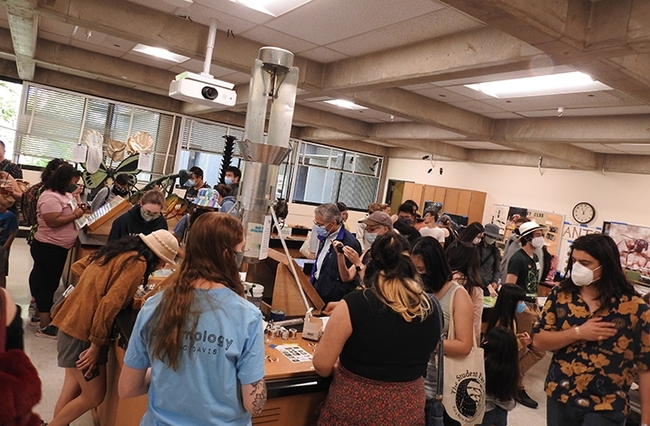
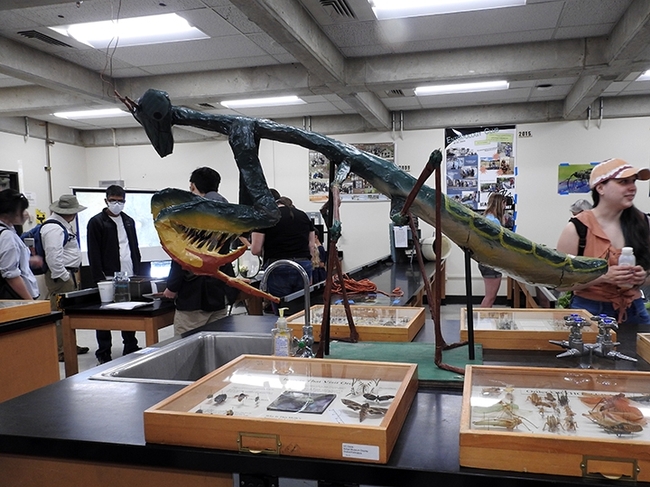
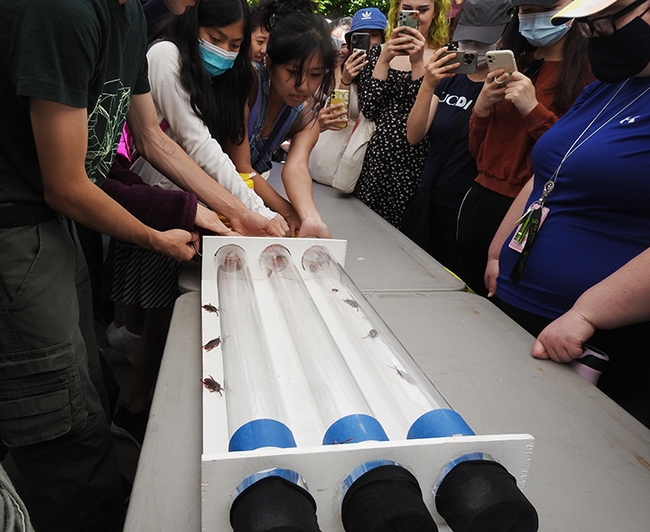
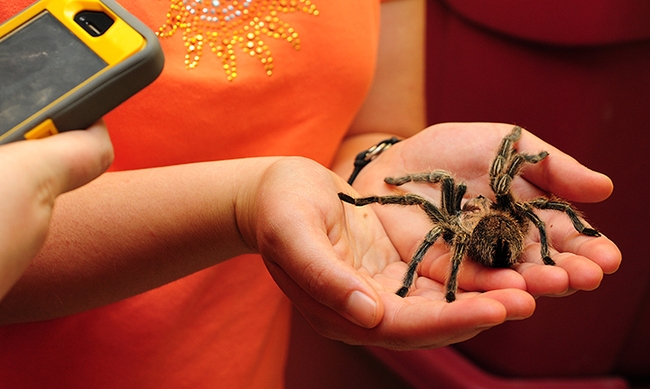
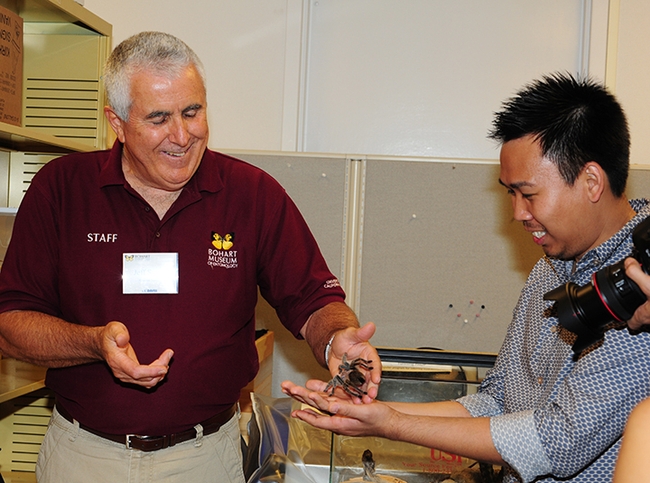
- Author: Kathy Keatley Garvey
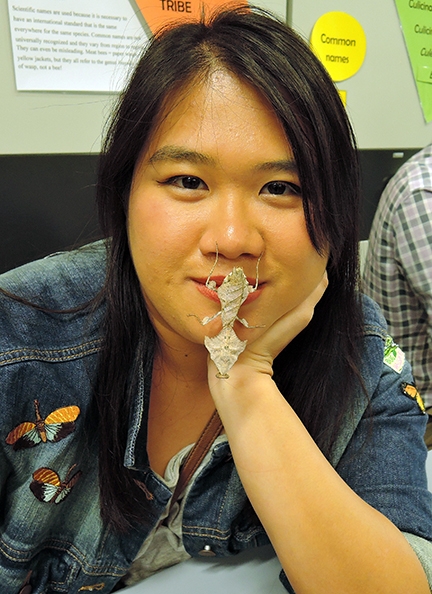
Visitors at the Bohart Museum of Entomology open house on Sunday afternoon, July 9 not only engaged in maggot art but conversed one-on-one with members of the North American Forensic Entomology Association (NAFEA), on campus July 7-12 for their annual conference. Forensic entomologist Robert Kimsey of the UC Davis Department of Entomology and Nematology, is a past president of the group.
Maggot art involves dipping a maggot into non-toxic, water-based paint and guiding it--or letting it crawl--on a piece of paper. It's suitable for framing or for refrigerator art.
Forensic entomologist Rebecca O'Flaherty, a former graduate student of Kimsey's, coined the educational teaching curriculum, "Maggot Art," back in 2001 when she was studying at the University of Hawaii. She was rearing blowflies for her forensic research and wanted an activity to draw the interest of elementary school students. She also wanted to generate interest and respect for forensic entomology.
Her Maggot Art quickly drew national interest. The CSI television show featured one of her works, “Ancient Offering,” which hung on the permanent set in Gil Grissom's office. O'Flaherty also exhibited her work at art shows, including a two-month exhibition at the Capital Athletic Club, Sacramento, in 2007.
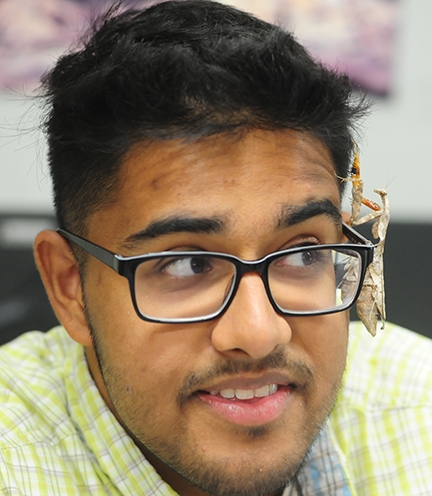
Neel Fulde, 7, of Davis, attending with his mother, Shama Mesiwala, created an obstacle-course drawing. "I'd like a faster maggot," he told NAFEA member Royce Cumming of Salinas Valley.
"As soon as I give it a bath," Cumming told him.
"I hope that one is faster than the one I have," Neel said. "I want a fast one."
Olivia Storms, 6, of Davis, attending with her father, David Storms, embellished her art with a colorful signature and whirls and swirls.
Adults tried their hand at it, too, including Jered Bell of Vacaville, aerospace engineering student at UC Davis and Alejandra Wilson of Fairfield, a biotechnology major at Solano Community College. "We've never done this before," Bell said. Maggot art is popular at the annual campuswide UC Davis Picnic Day, when the UC Davis Department of Entomology and Nematology offers the activity at Briggs Hall.
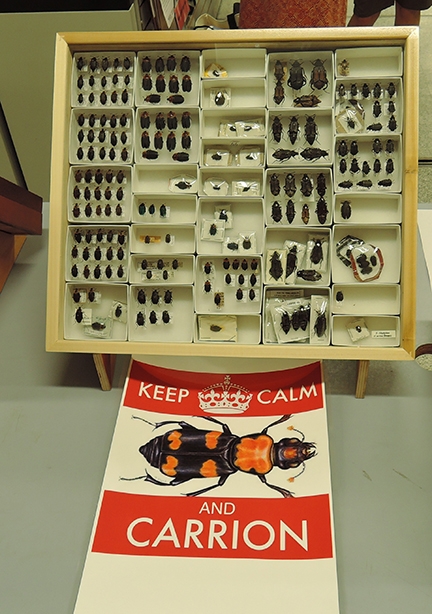
NAFEA member Greg Nigoghosian of Purdue University wore a T-shirt, the work of Purdue students, that read "Crime Scene: Do Not Cross," that included a body outline and the words "Our day begins when your day ends."
The goal of NAFEA is to promote the development of forensic entomology throughout North America and to encourage co-operation with other similar international bodies. NAFEA defines its mission as “to provide a cooperative arena for forensic entomologists to interact and collaborate in ways that enhance the science, moral and ethical foundation, and reputation of forensic entomology.”
The July 9th open house is the first of three open houses during the summer. All are free and open to the public.
Saturday, July 22, Moth Night from 8 to 11 p.m.: Moth Night, held in conjunction with National Moth Week, will enable visitors to explore nighttime nature through a blacklighting setup, enabling the collection of moths and other insects. The event takes place in the courtyard in back of the Bohart Museum. The museum will be open throughout Moth Night.
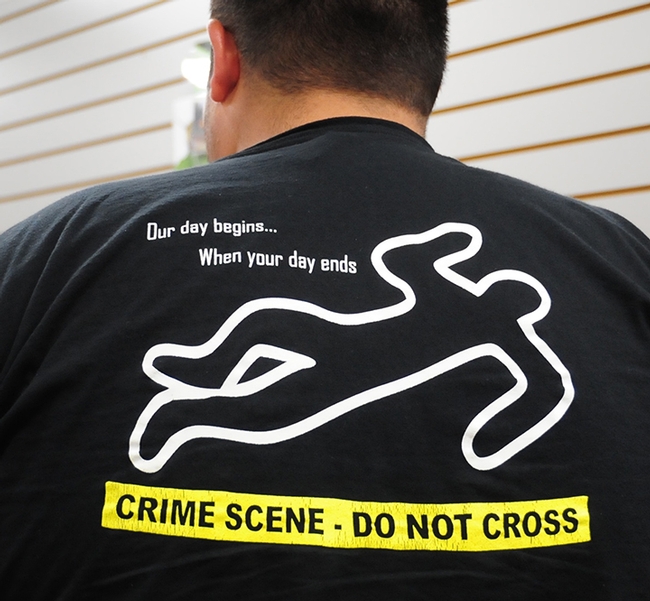
The Bohart Museum, directed by Lynn Kimsey, professor of entomology at UC Davis, houses a global collection of nearly eight million specimens. It is also the home of the seventh largest insect collection in North America, and the California Insect Survey, a storehouse of the insect biodiversity. Noted entomologist Richard M. Bohart (1913-2007) founded the museum.
Special attractions include a “live” petting zoo, featuring Madagascar hissing cockroaches, walking sticks and tarantulas. Visitors are invited to hold the insects and photograph them.
The museum's gift shop, open year around, includes T-shirts, sweatshirts, books, jewelry, posters, insect-collecting equipment and insect-themed candy.The Bohart Museum's regular hours are from 9 a.m. to noon and 1 to 5 p.m. Mondays through Thursdays. The museum is closed to the public on Fridays, Saturdays and Sundays and on major holidays. Admission is free.
For more information contact the Bohart Museum at (530) 752-0493 or bmuseum@ucdavis.edu
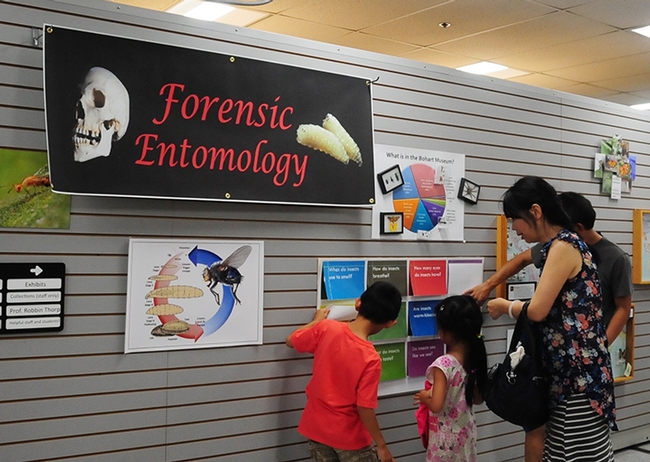
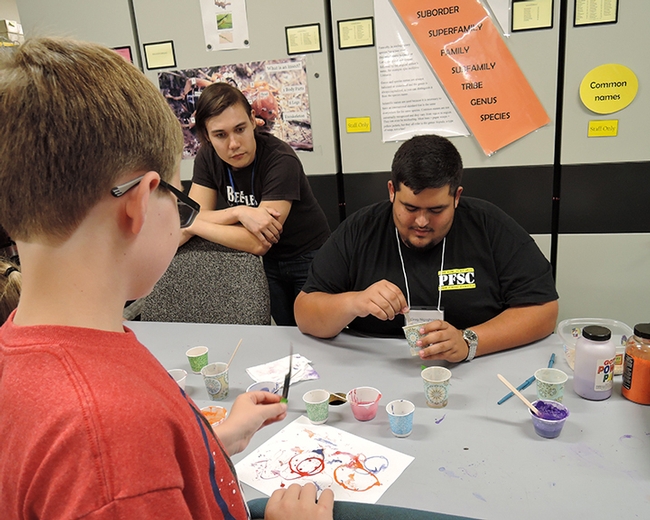
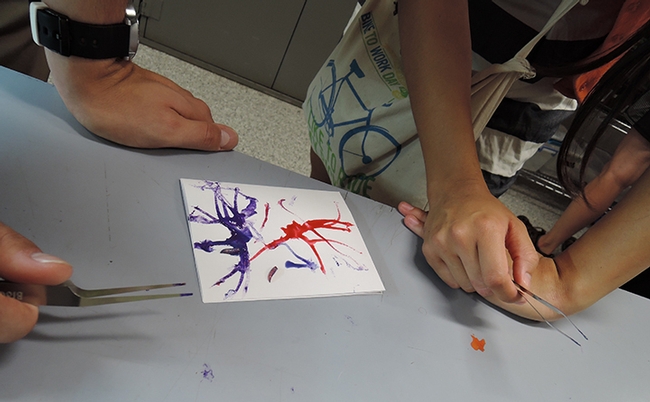
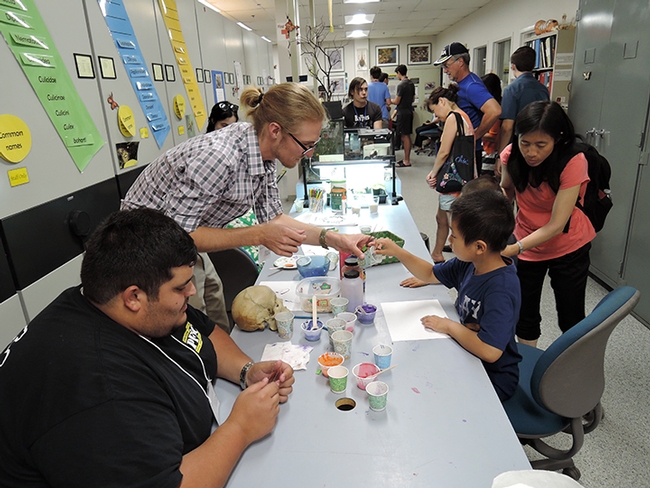
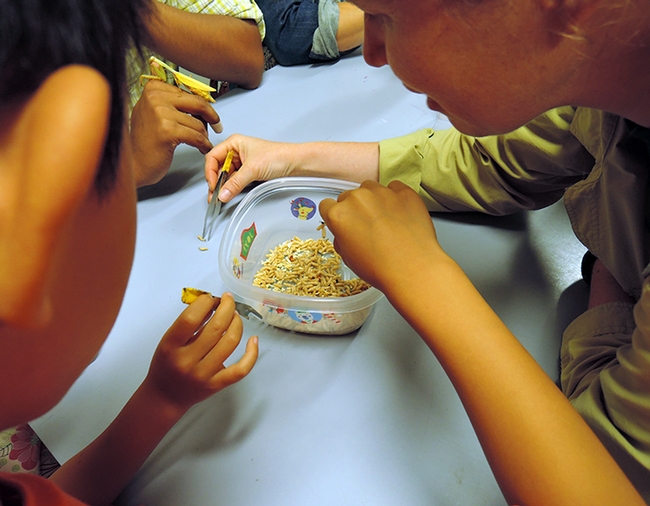
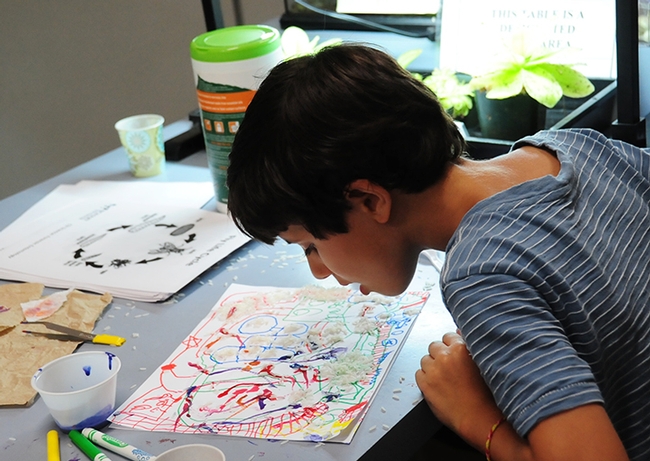
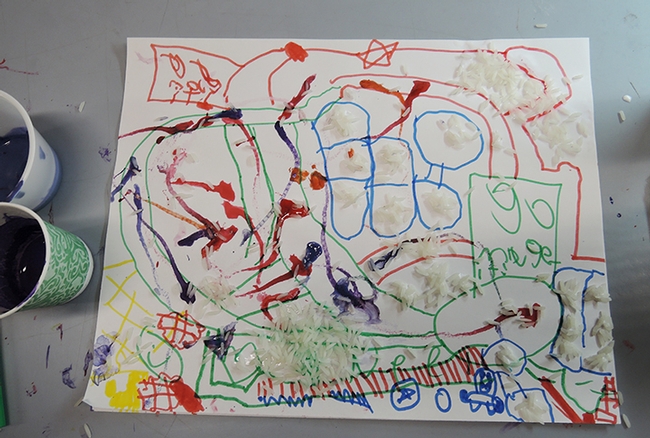
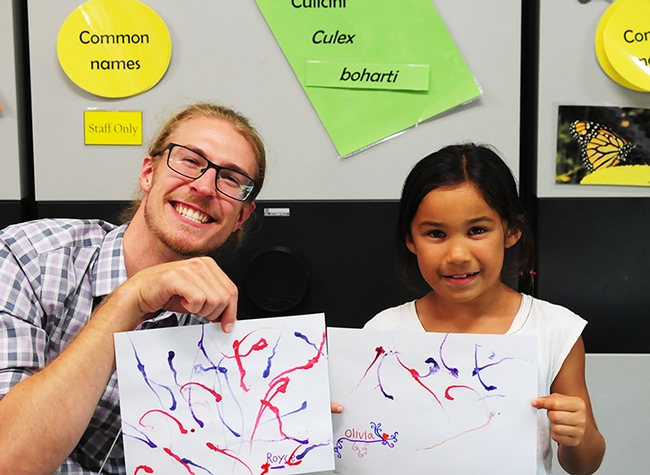
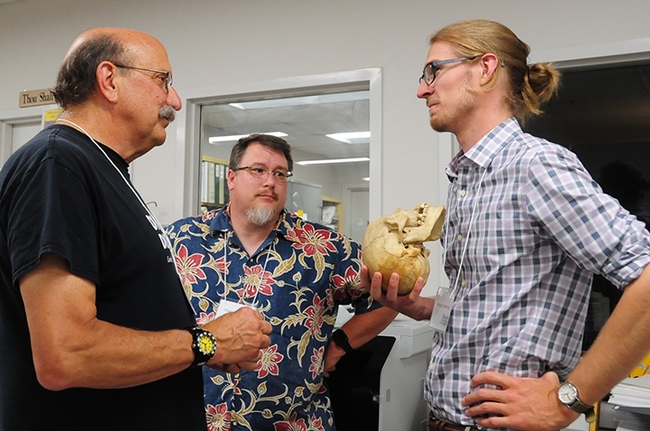
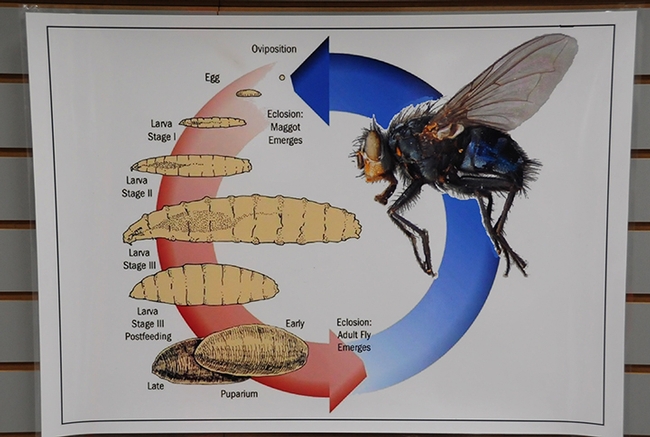
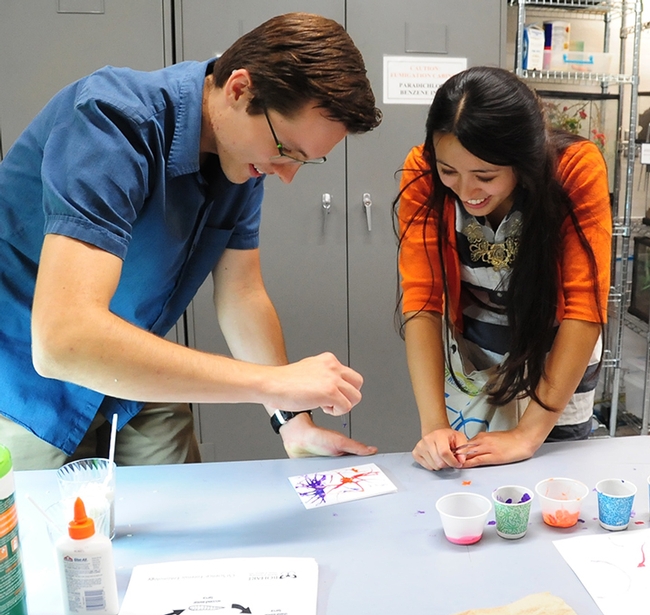
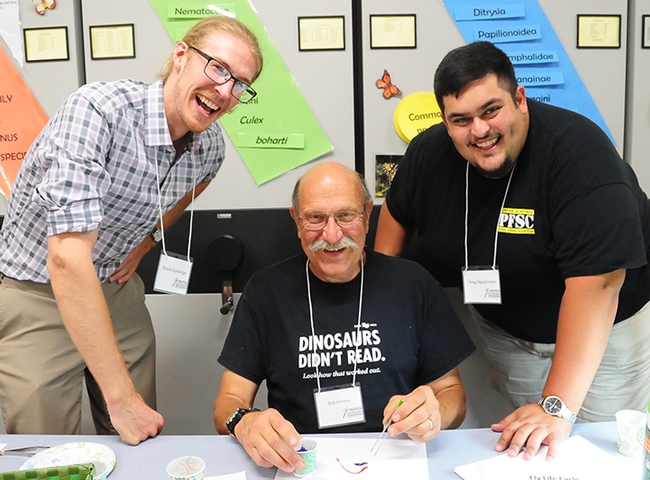
- Author: Kathy Keatley Garvey
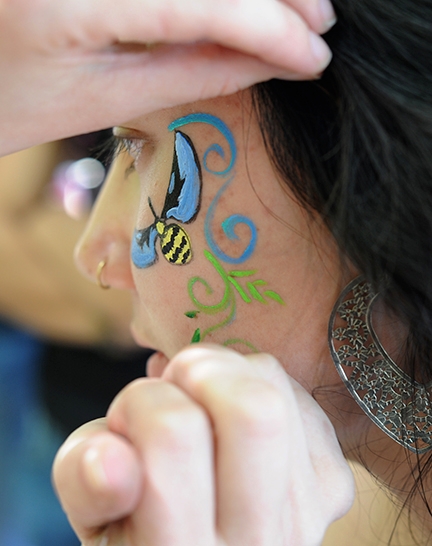
The UC Davis Department of Entomology and Nematology is planning scores of insect-related activities for the 103rd annual campuswide UC Davis Picnic Day on Saturday, April 22.
What's new this year in the department's line-up will be an insect scavenger hunt, replacing the Pollinator Pavillion, said Brendon Boudinot of the Phil Ward lab, chair of the department's Picnic Day Committee.
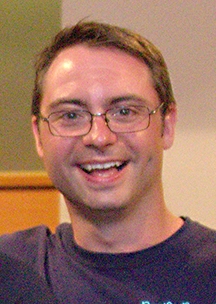
The campuswide Picnic Day gets underway at 9:30 a.m. with an opening ceremony by the grandstands on North Quad Ave., across from Wickson Hall. The parade starts at 10 a.m. from the same site. Announcement locations are at 2nd and D streets in downtown Davis; F Street in front of PDQ Fingerprinting, and 3rd and C streets in downtown Davis. The UC Davis Entomology Club, advised by forensic entomologist Bob Kimsey, will enter its popular black widow float.
The Briggs Hall activities will be open from 10 a.m. to 4 p.m., but the cockroach races will close at 2 p.m.
The list of activities at Briggs:
- Honey Tasting (You can sample varietals of honey)
- Bug Doctor (The doctor is in!)
- Cockroach Races (Pick a winner)
- Scavenger Hunt (Do you know your insects?)
- Dr. Death (Forensic entomologist Robert Kimsey will answer your questions)
- Insect Face Painting (Get a bee, lady beetle or another insect painted on your face)
- Little Swimmers and Fly Tying (Watch and identify aquatic insects, a project from the Sharon Lawler lab, and learn "how to tie a fly" from the Fly Fishers of Davis
- Maggot Art (Dip a maggot into a water-based, non-toxic paint and create a painting suitable for framing)
- UC Statewide Integrated Pest Management (UC IPM) (See their many publications and ask questions; youngsters can receive a vial of free lady beetles, aka ladybugs)
- T-shirt sales by the UC Davis Entomology Graduate Students' Association (popular t-shirts include beetles and honey bees)
- Social insects, insect forestry, medical entomology, and more (See a honey bee observation hive from the Harry H. Laidlaw Jr. Honey Bee Research Facility and ants from the Phil Ward lab; and also learn about forest insects and mosquitoes. The Sacramento-Yolo Mosquito and Vector Control District will staff a booth)
The Bohart Museum of Entomology in Room 1124 of the Academic Surge Building will swing open its doors from 10 a.m. to 3 p.m. The theme: "Bigger, Better and Buglier: Impressive Science at the Bohart." This will be an opportunity to see some of the nearly eight million specimens, visit the live petting zoo (Madagascar hissing cockroaches, walking sticks and taranatulas) and ask questions of the scientists.
The nematology collection will be on display in the Sciences Laboratory Building, across from Briggs.
Theme of this year's Picnic Day is "Growing Together." The schedule can be downloaded from the campus website.
